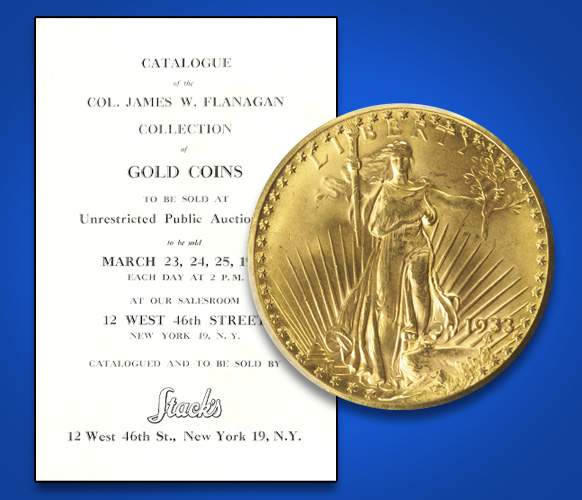
The saga of the world’s most valuable coin, the 1933 double eagle, is studded with the names of early-to-mid-20th century American numismatics greats. Many of the era’s most famous collectors, dealers, and auction houses handled 1933 double eagles in the 1930s and early 1940s, mostly unaware of the coins’ illicit origins. Stolen from the Treasury’s vaults at some point before 1937, the date by which all 1933 double eagles would have been melted – 1933 double eagles trickled into the market, snapped up by and added to the numismatic cabinets of the well-connected and well-capitalized. Among these well-heeled collectors was Col. James Flanagan, a petroleum engineer and banker who had consigned his large, varied collection of gold coins (which included a 1933 double eagle), to a successful fledgling numismatic auction firm called Stack’s.
Established in 1933, Stack’s held its first auction in 1935 and by the early-to-mid-1940s had asserted itself as a formidable player in the competitive New York numismatic scene. Keen to pick up major consignments, Stack’s was preparing to auction Flanagan’s collection and took out an ad in The Numismatist estimating 8-10 examples of the 1933 $20 were known. Stack’s, perhaps a bit hyperbolically, estimated that their sale would set the world record for aggregate prices realized: “WE EXPECT THIS SALE TO REALIZE THE WORLD’S RECORD IN TOTAL AMOUNT OF DOLLARS.” They aptly described the 1933 double eagle as “excessively rare and in great demand.”
The sale caught the attention of Ernest Kehr, a philatelist and Stamp and Coin Editor for the New York Herald Tribune, who looked at the catalog and was surprised to see the 1933 double eagle valued between $1,000 and $2,200, an astronomical sum for a coin at the time. He contacted Dr. Leland Howard, Assistant Mint Director, who found that no 1933 double eagles had been issued. Howard contacted the Secret Service, which launched an investigation culminating in the recovery of numerous 1933 double eagles from prominent collectors and dealers, including from the Stack brothers, who surrendered the Flanagan coin on March 24, 1944.
Stack’s was not the first firm to publicly advertise a 1933 double eagle. Advertisements for the exceedingly rare coin had appeared in numismatic publications before 1944 and F.C.C. Boyd, one of the era’s most prominent and well-connected collectors, had exhibited his coin publicly since the late 1930s.
Interested readers are encouraged to read David Tripp’s Illegal Tender: Gold, Greed, and the Mystery of the 1933 Double Eagle and Alison Frankel’s Double Eagle: the Epic Story of the World’s Most Valuable Coin.





